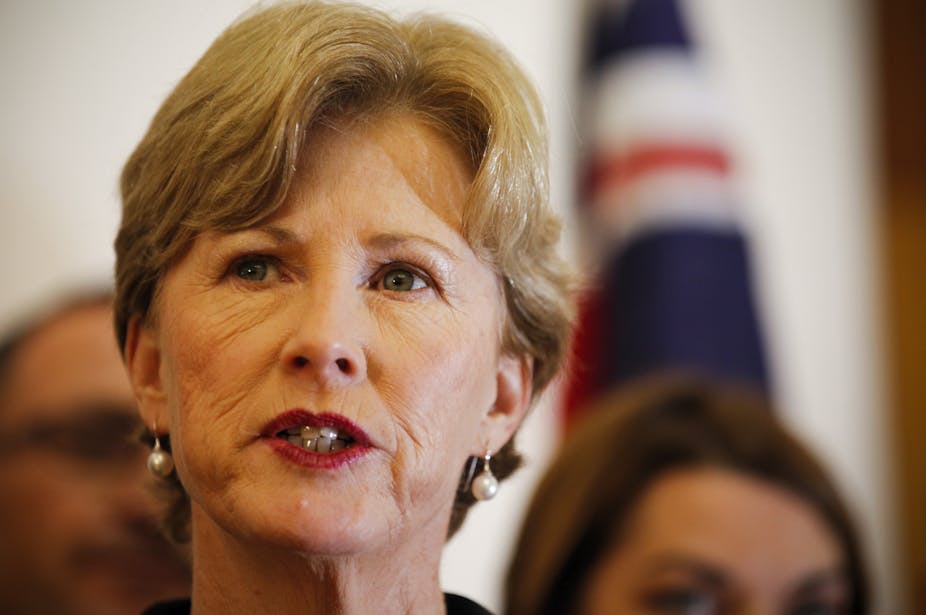Bob Brown’s decision to resign as leader of the Greens last Friday marks a new and interesting phase in the evolution and development of the Australian Greens.
Brown’s exit from the Senate in June inevitably invites questions about the party’s prospects without him, as well as questions about the suitability of Christine Milne as his replacement.
But Milne is already flexing her new leadership muscle – taking on the government over company tax breaks, public service job cuts and challenged the need for a budget surplus.
In fact, despite some doom and gloom around the party’s chances without Brown, there’s now a real opportunity for the party to grow under a new leadership.
The Greens’ solid base
The Greens are unlikely to be significantly diminished by Brown’s departure, even if he has been the familiar face of the party at the national level since his election to the Senate in 1996.
Unlike the ill-fated Australian Democrats, the Greens’ electoral success does not appear to be especially dependent on the popularity of its leader.
The level of support for the Greens within the electorate has been growing steadily since its inception, increasing at all but one federal election between 1996 and 2010.
The party’s primary vote has been devoid of significant volatility, which seems to suggest that it’s drawing much of its support from partisans, not from disenfranchised major party voters.
This is further supported by Australian Election Study survey data which shows that the number of voters who profess affective ties to the Greens has risen from 1.2% in 1996 to 5.9% in 2010.
Importantly, the Greens’ voter base shares certain underlying socio-demographic as well as attitudinal characteristics in common.
While this segment of the electorate is small in numerical terms (estimated by scholars at approximately 10% of the population), the fact that the Greens appear to have mobilised a distinctive constituency is an important step towards establishing genuine longevity in the Australian party system.
Time for renewal
If anything, Brown’s decision to retire from the Senate presents an important opportunity for the party.
First, his exit guarantees that the party’s fortunes do not become unhealthily linked to one particular person, as might have occurred the longer Brown remained in the Senate.
Second, Brown’s decision to retire before the expiration of his term will allow his replacement the opportunity to settle into the Senate and to establish their profile ahead of the 2013 poll.
Third, and perhaps most significantly, Brown’s retirement allows the remaining Greens MPs to step out from the long shadow that his presence has cast.
For more than a decade, Brown’s authority both within and outside of the Party has made it difficult for many of the Greens MPs to gain greater public prominence.
As the established parties well know, there must exist opportunities for promotion and advancement within the ranks in order to prevent the more ambitious members of the parliamentary wing from growing restless.
Sarah Hanson-Young’s unsuccessful challenge to Milne’s deputy leadership in late 2010 demonstrates that even Greens politicians may harbor their share of personal ambition.
Milne as leader
The party room’s decision to elect Christine Milne as leader is a sensible choice that will ensure continuity and stability.
It is important to remember that this is not the first time Milne has been called upon to fill Brown’s shoes. She took over as parliamentary leader of the Tasmanian Greens when he quit to contest the federal lower house of Denison in 1993.
The two Senators have enjoyed a close working relationship, as well as a set of intersecting political experiences.
Brown and Milne are largely accidental politicians whose parliamentary careers were galvanised by environmental causes.
Both spent many years in the Tasmanian Legislative Assembly where together they survived the turbulent 12 months of minority government under the [Field ALP government](http://en.wikipedia.org/wiki/Michael_Field_(Australian_politician).
Between 1996 and 1998 when the Tasmanian Greens once again held the balance of power in the Tasmanian Parliament, Milne revealed herself to be skilled parliamentary tactician.
And in the years following Milne’s defeat at the Tasmanian state election in 1998 until her subsequent election to the Senate in 2004, she served as Brown’s political adviser.
How long Milne remains in the leadership role is quite another matter, however. While clearly an earnest politician, and an experienced pair of hands, she lacks some of the natural charisma possessed by her colleagues.
This isn’t to say that Milne will be challenged in the short term (or certainly before the 2013 election). But in the post-Brown era, a new figure may emerge within the party room who commands the same level of respect and authority Bob Brown enjoyed.

